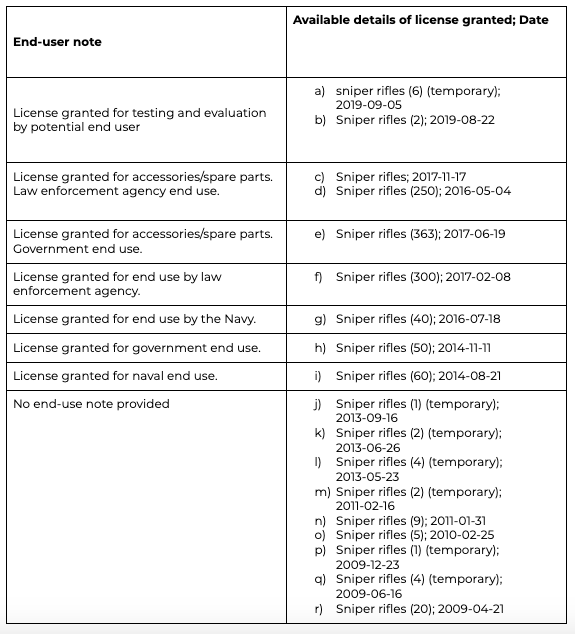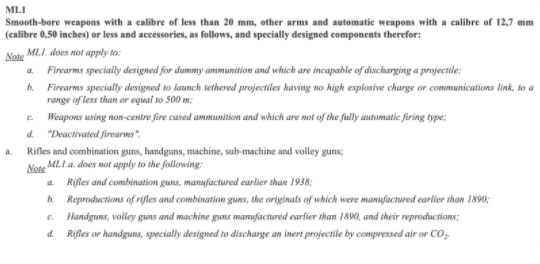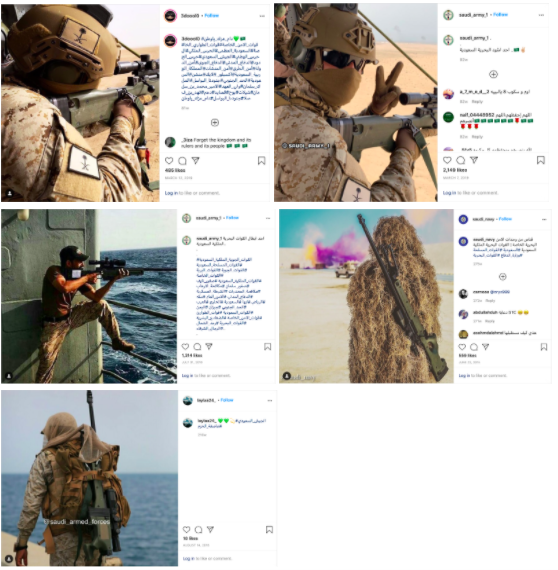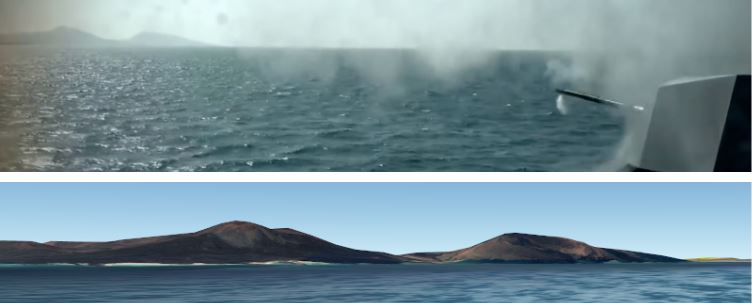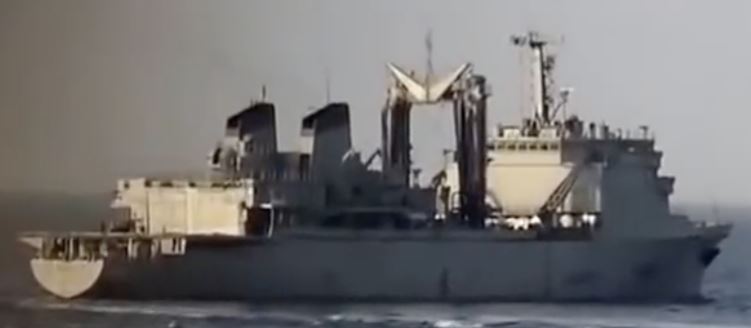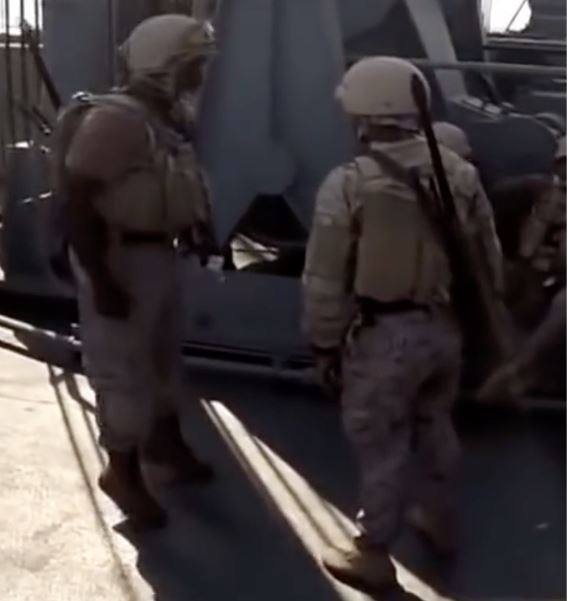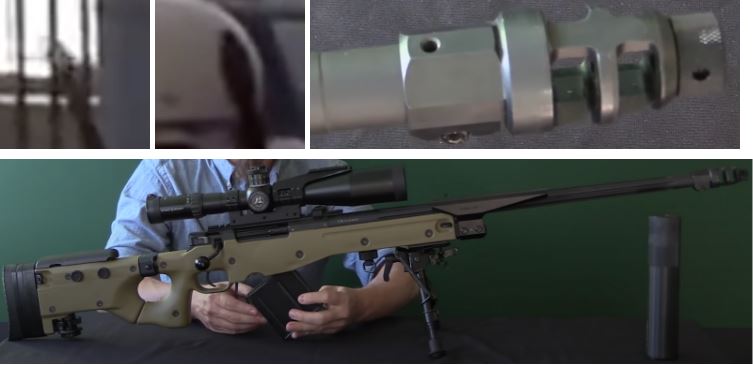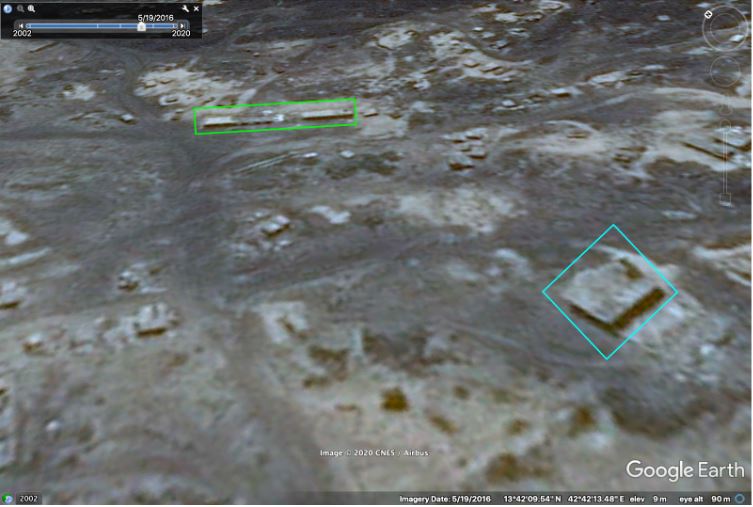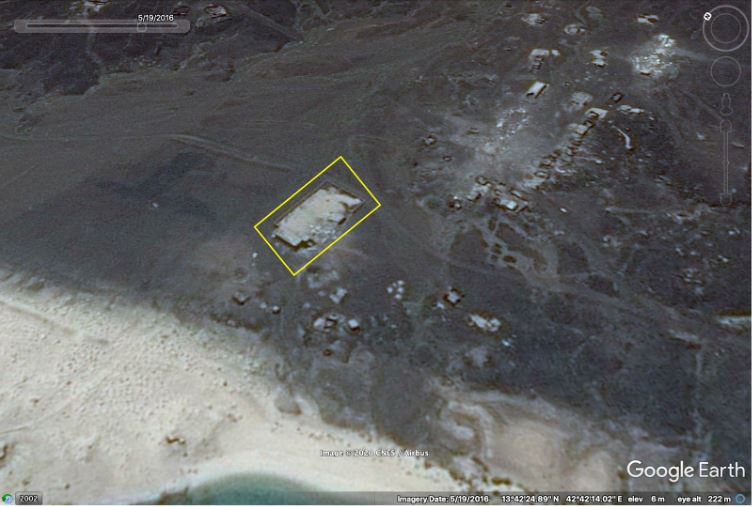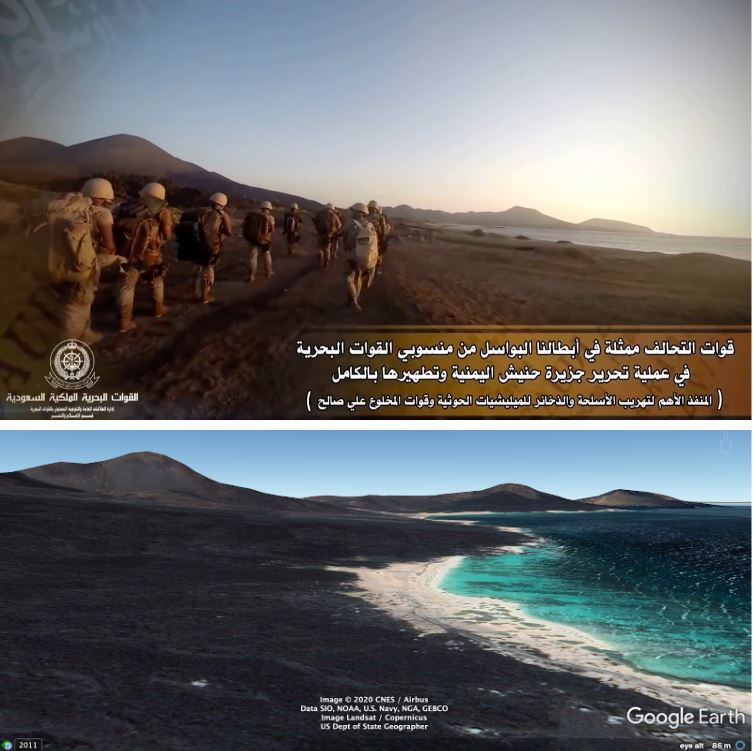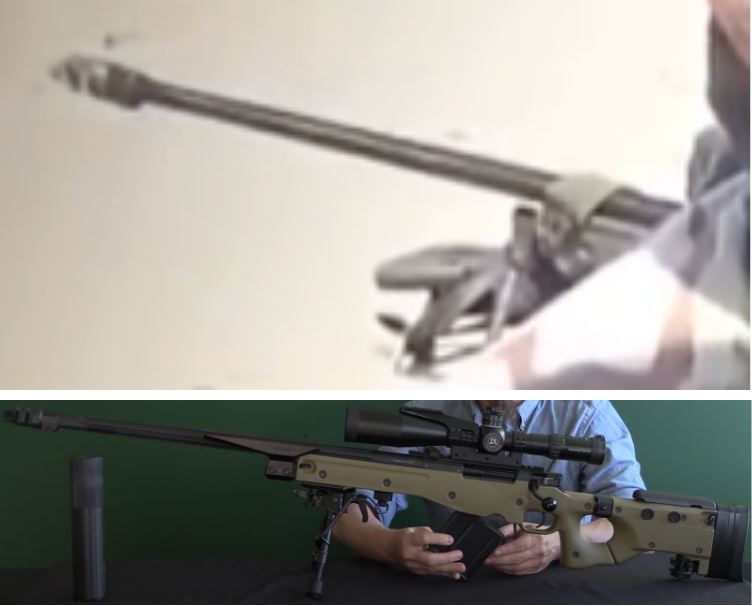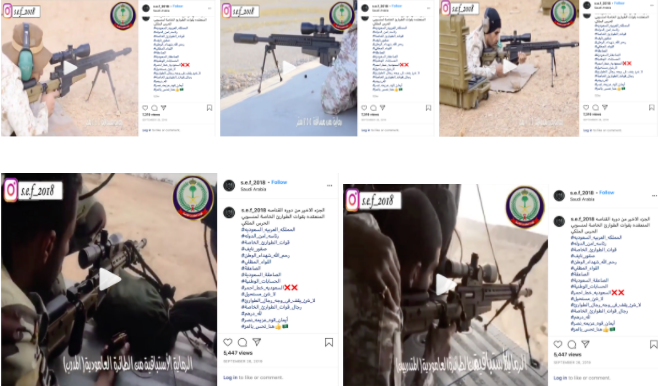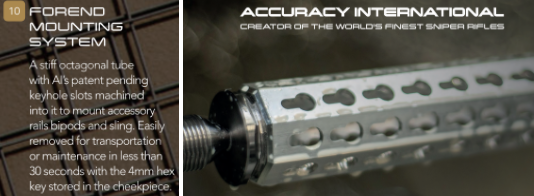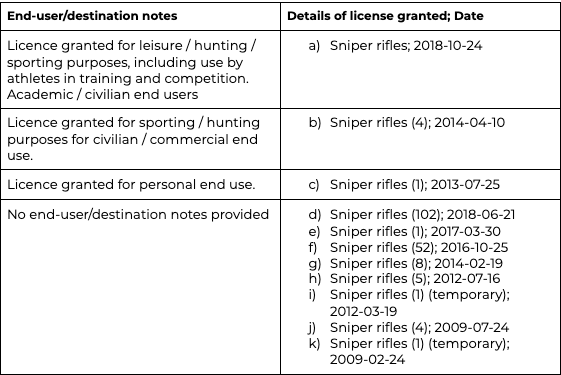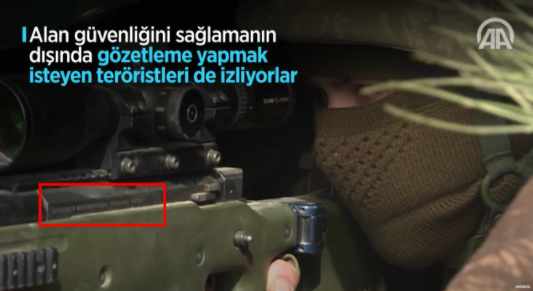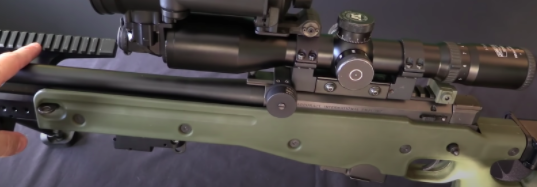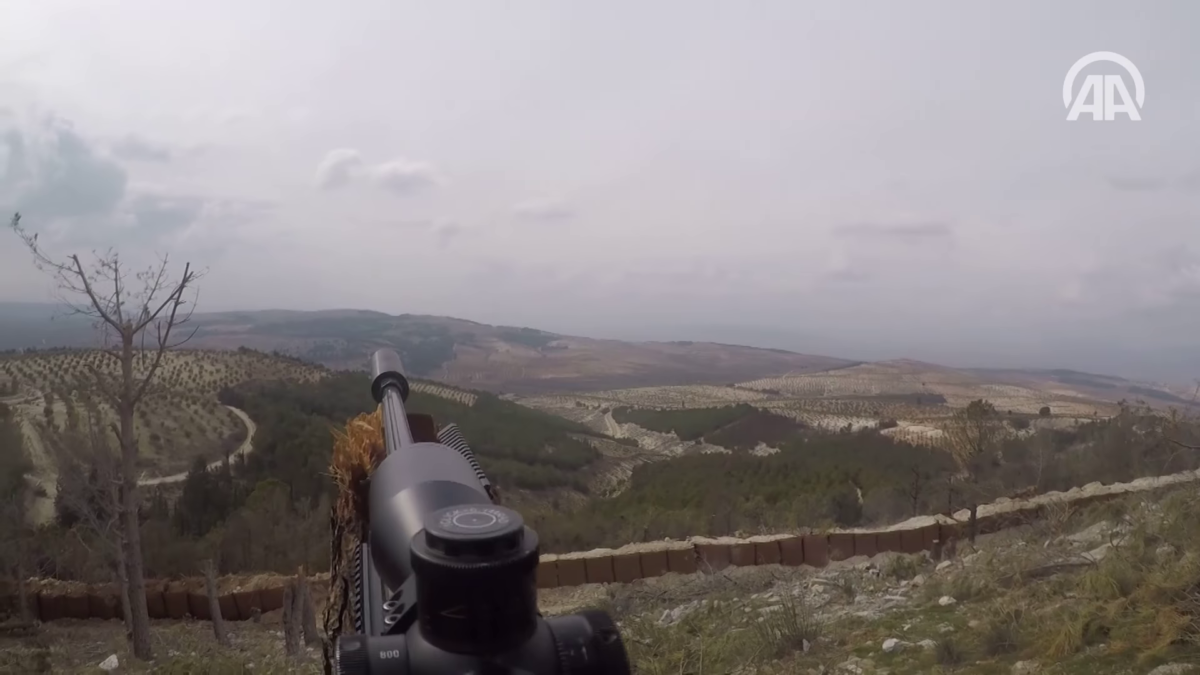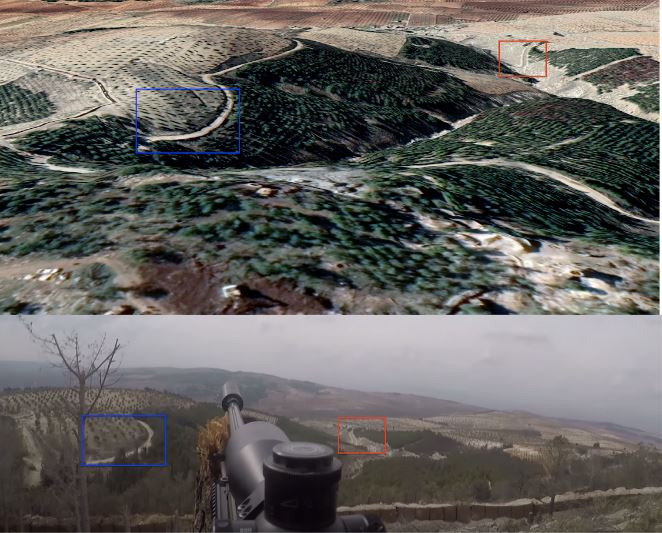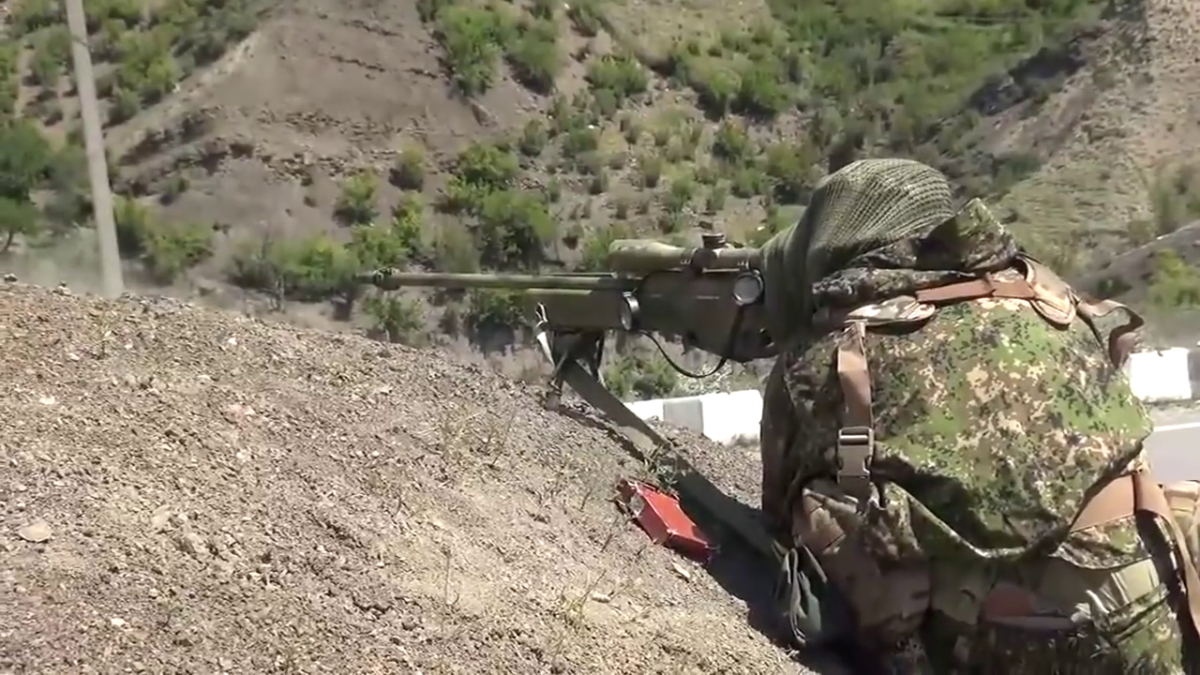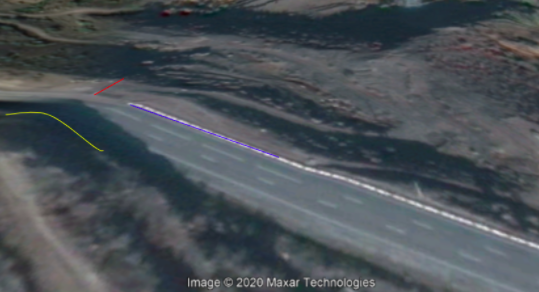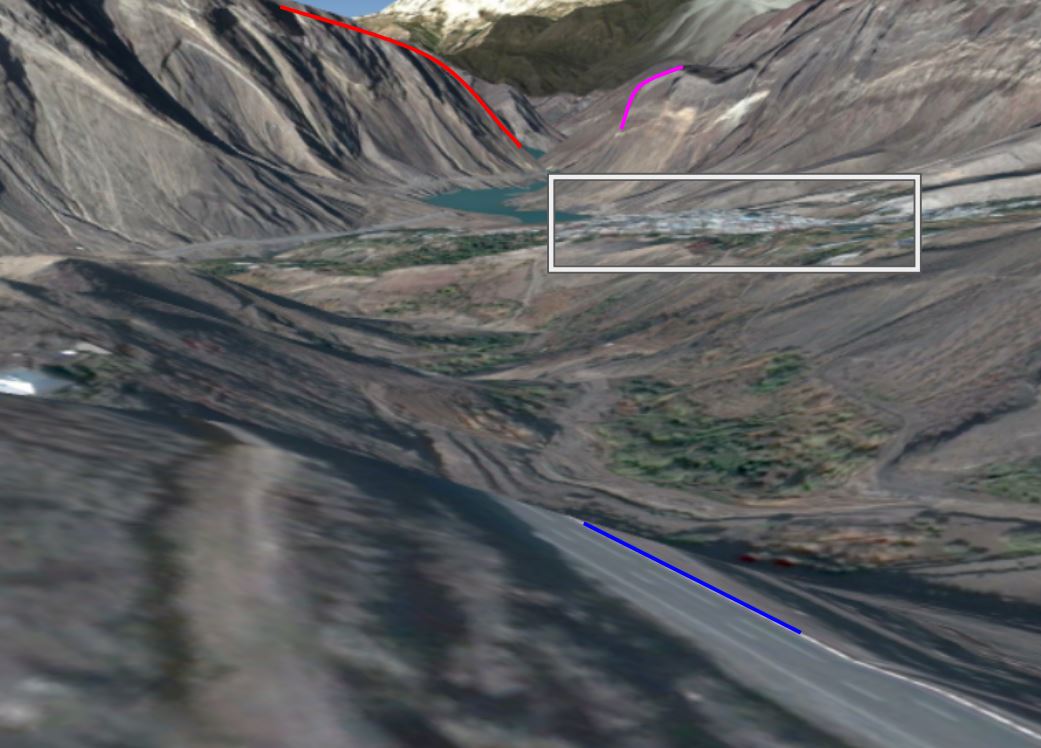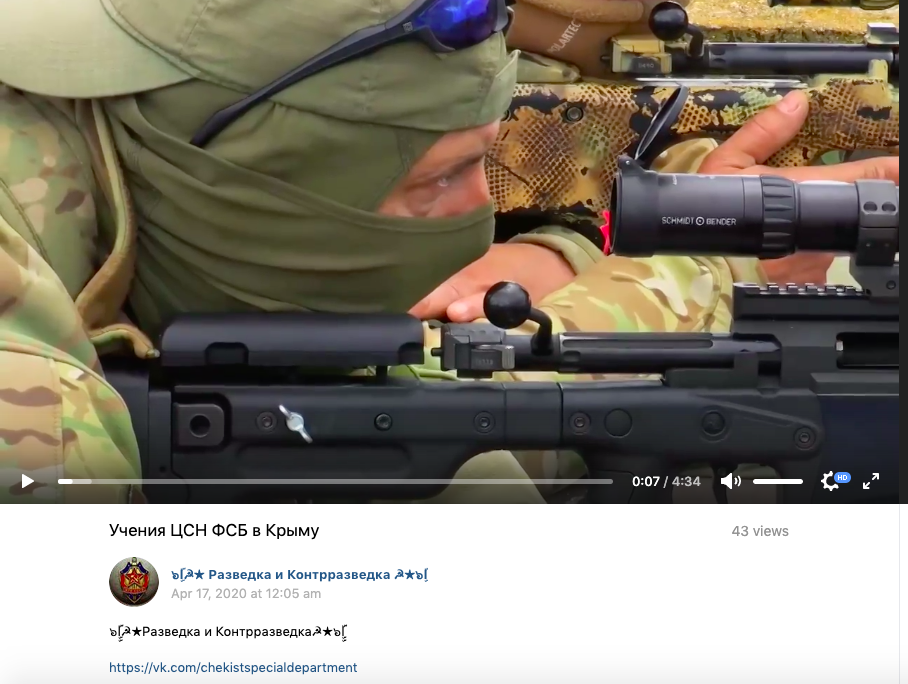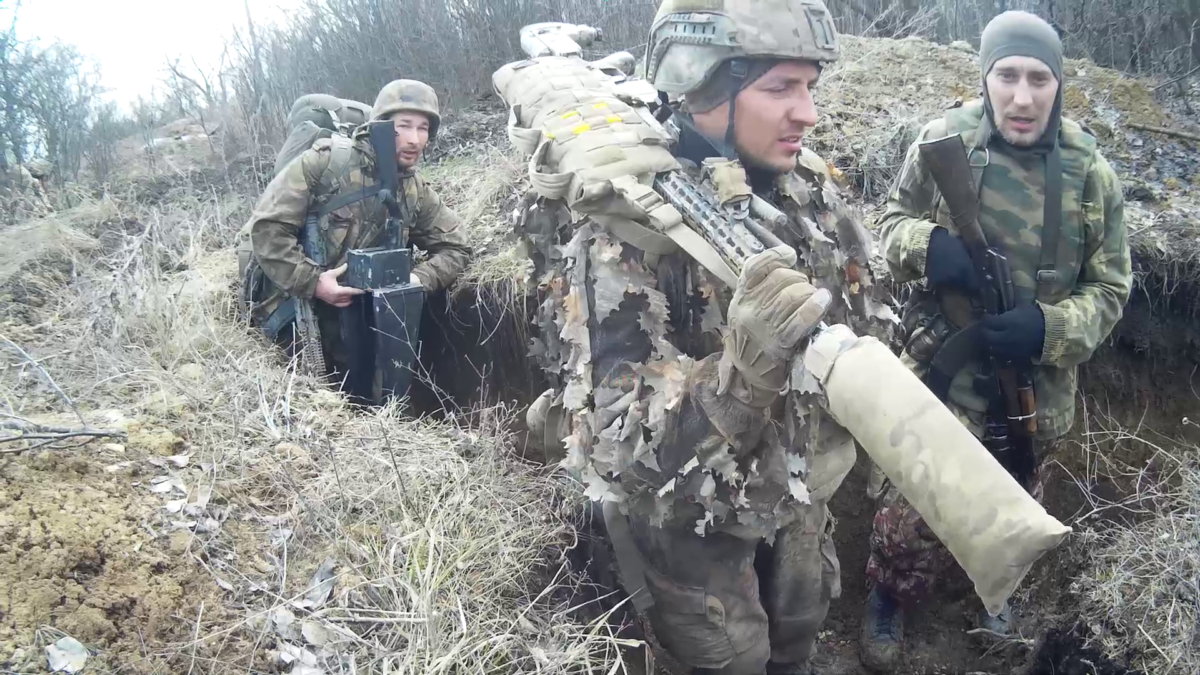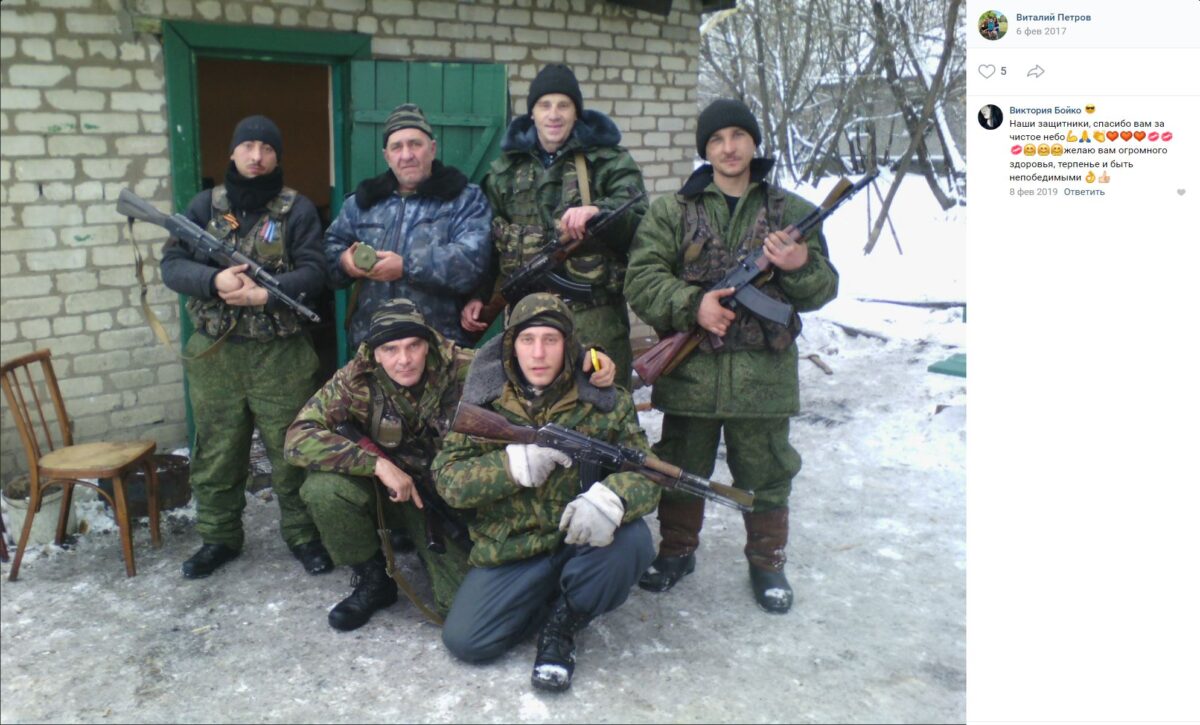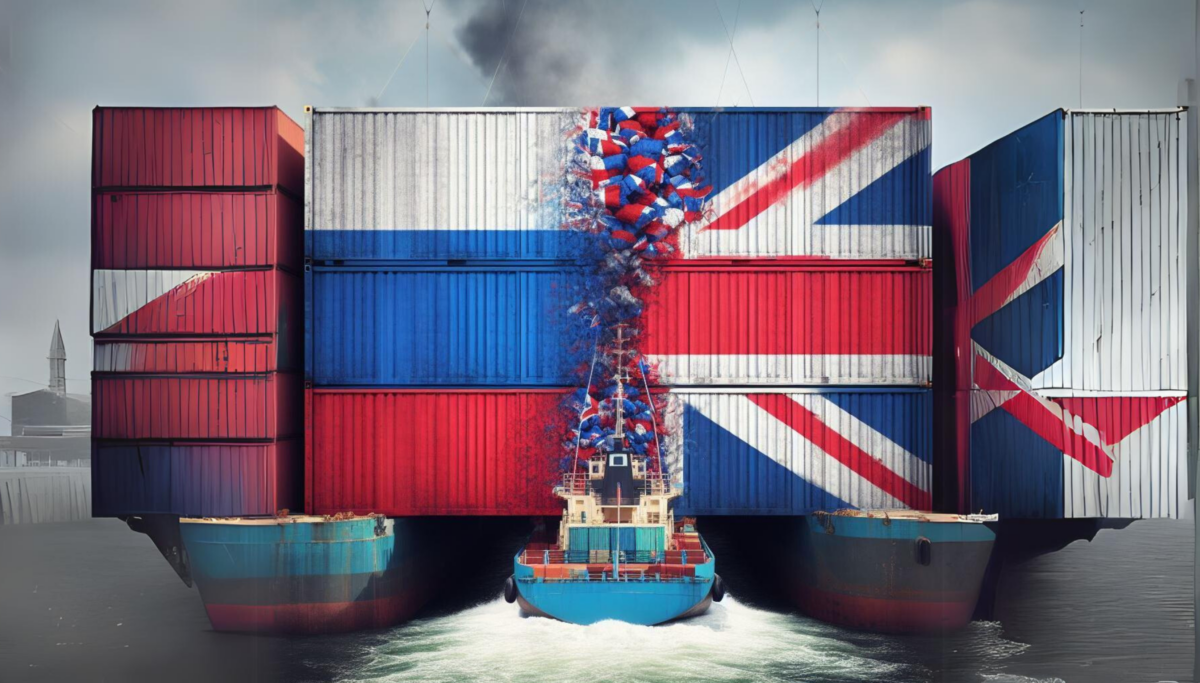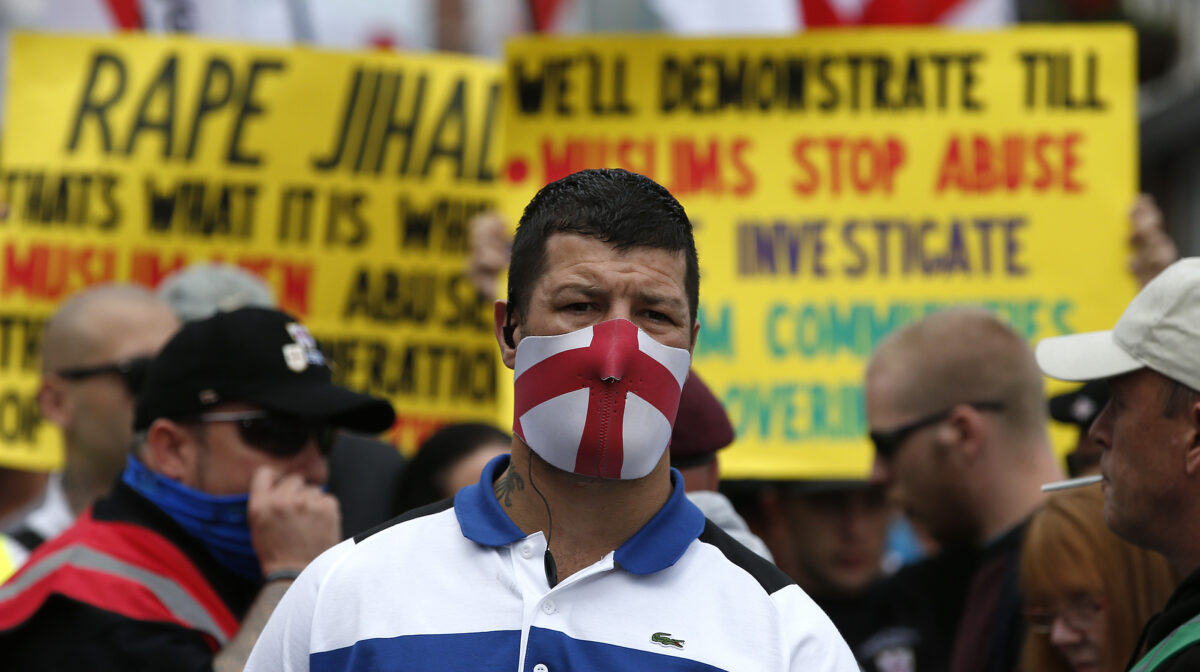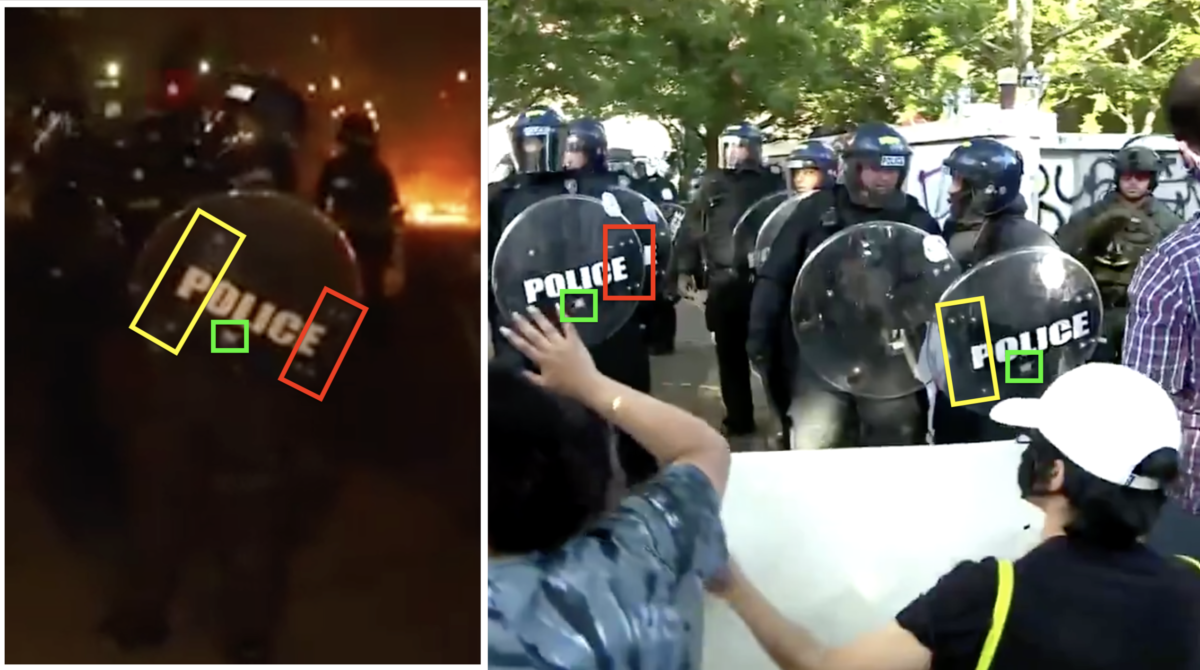How British-made sniper rifles ended up in Yemen, Syria and Ukraine
A note about the UK Arms project: This article forms part of a series of investigations that will look at UK arms exports. It has been produced by Bellingcat, Lighthouse Reports and their media partners, Sky News and The Guardian. Investigators involved were Leone Hadavi, Benjamin Strick, Annique Mossou, Pieter van Huis, Eric Woods, Ross Higgins and Ludo Hekman. Part one, featured here, will look at sniper rifles sold by a UK arms company. Part two will focus on equipment used by US police at recent Black Lives Matter protests, while part three will explore the sale of recoilless rifles used by Saudi Arabia in the ongoing Yemen conflict.
While the UK is renowned for big ticket arms exports such as the EF Typhoon and Tornado fighter jets, it also has a thriving light-weapons industry.
These reports will look to see where UK-made small arms end up and whether, in granting licenses for such sales, the UK is living up to its claim of having strict and rigorous arms export controls.
These investigations are part of the larger EU Arms project initiated by Lighthouse Reports, which looks to document and track how EU-manufactured weapons are used. The project has set-up newsrooms in eight major arms exporting countries and, thus far, investigated close to 100 export agreements. You can read more about the EUArms project here.
The Record Breaking Sniper Rifle
Accuracy International (AI), a British based firearms manufacturer has made a name for itself selling sniper rifles around the world. Its products are renowned for their reliability, durability and are generally considered as some of the best on the market.
The range of the rifle can provide a warring party with a significant advantage over its opponents – back in 2009, British soldiers used the rifle to take out two Taliban fighters in Afghanistan from a distance of 2,475 meters (thereby breaking what was then the “world record” of longest recorded sniper kills).
The rifle has been exported to many countries around the globe. We traced a few of these exports, and tried to reconstruct the full circle: from license, to export to actual deployment.
While doing so, however, we began to wonder whether UK arms export control mechanisms were effective given some of the locations we saw these weapons appearing in.
The UK is a signatory to the International Treaty on Arms Trade (ATT), which looks to regulate the cross-border trade in conventional arms. It has also implemented the EU common Position on Arms Exports and has its own domestic rules that aim to prevent licenses being granted when there is a risk recipients would use them aggressively against another country or for internal repression. These rules also state that caution must be taken in granting licences, on a case-by-case basis and taking account of the nature of the equipment, to countries where serious violations of human rights have been established.
In responding to the research conducted for the UK Arms project, a UK government spokesperson said the country operates “one of the most comprehensive export control regimes in the world” and “rigorously assesses all export licences in accordance with strict licensing criteria.”
Yet despite that, we were able to find Accuracy International sniper rifles appearing in Russia’s volatile North Caucasus region as well as conflict zones in Ukraine, Yemen, and Syria.
Accuracy International did not respond to requests for comment for the UK Arms project before publication. There is no suggestion of any illegality on their part.
Saudi Sales
UK sniper rifle sales to Saudi Arabia have increased in recent years, even as Saudi forces have engaged in a brutal conflict in neighbouring Yemen.
Documents submitted by the UK to the Arms Trade Treaty show that 663 sniper rifles were exported to Saudi Arabia in 2017. A year earlier, that figure stood at 290.
At the same time, data collected by the Campaign against the Arms Trade (CAAT) from UK Strategic Export Controls reports shows that 23 licenses have been granted for the sale of sniper rifles to Saudi Arabia since 2008. Of these, 18 are Standard licenses (SIELs: Standard Issue Export Licenses), which can be used to send a single shipment overseas, and five are ‘open’ licenses (OITCLs: Open Individual Trade Control License).
Of the five open licenses, end destination notes are available for two of them. A 2017 OITCL granted the sale of sniper rifles, among other things, for “anti-piracy operations. Civilian/commercial end use.” A 2016 OIEL was granted for: “for accessories / spare parts. Armed forces end use.”
The 18 SIELS were granted with the following destination notes:
Through data provided in response to Freedom of Information requests by CAAT, we were able to see that Accuracy International applied for a license to sell ML1a items (detailed in the image below) to Saudi Arabia at least seven times over the period between September 2007 and December 2015. Given the FOI request was submitted in 2016, it is possible that AI applied for more licenses to sell ML1a items after these dates.
Yet due to paucity of the data in the SIEL and OITCL end notes, it is not possible to say which, if any, of the approved licenses were awarded to Accuracy International.
But what if we were to take a look at the weapons that appear to be being used by the Saudi armed forces in training and in the field?
Images posted to unofficial and enthusiast Instagram pages that celebrate the Saudi army and navy appear to show uniformed men holding rifles that bear a very close resemblance to the AI Arctic Warfare series model (as seen below)
While this cannot be taken as full confirmation, given the unofficial nature of the Instagram pages, it does align with the hypothesis that AI rifles had been sold to the Saudi Navy.
Image: Pictures posted to Instagram that appear to show Saudi forces with AI rifles. Original sources here, here, here, here and here
The absence of an adjustable cheekpiece in the Instagram images appears to indicate these rifles belong to the Arctic Warfare (AW) model publicised in this official Accuracy International brochure from 2005.
Barrels, as demonstrated by the variety of those showcased in social media posts and in the brochure, are changeable and vary in calibre, but all can be mounted in the Arctic Warfare chassis.
Locating Accuracy International rifles in Yemen
On December 10, 2015, the Royal Saudi Navy released footage of an operation in the Hanish Islands, which belong to Yemen.
The original video is now unavailable and the Navy’s official social media accounts and website have been taken down, although the footage was also uploaded by other unofficial social media channels. The video bears the official logo of the Royal Saudi Navy and is consistent with the official material shared by the Navy with the international press. It can be viewed below.
The Hanish Islands are strategically located in the Red Sea, midway between the coasts of Yemen and Eritrea, close to the Bab Al-Mandab Strait. As reported by Reuters and Al-Jazeera, Saudi forces took control of the islands because they along with their coalition partners, believed they were being used by Houthi rebels to “store and smuggle weapons into Yemen.” The same media channels, quoting local testimonies, stated that “the islands had been under heavy shelling by Arab forces for weeks before they were seized”.
The footage released by the Royal Saudi Navy begins with shells being fired by one of the vessels participating in the operation towards a territory that appears to be the southern tip of Jazirat Al Hanish Al Kabir, the southernmost of the two main islands of the Hanish archipelago. The lowest point in elevation between the two visible peaks corresponds to this location (13.676097, 42.684568).
Image top: A still from Royal Saudi Navy footage released on December 10, 2015. Bottom: A screen grab from Google Earth.
The footage then shows Saudi military personnel on a military support ship. By the outlines it appears to be one of the two Boraida-class replenishment ships in service with the Royal Saudi Navy. A photographic comparison of the vessel can be made with this image posted to ShipsSpotting.com.
Image: A still from Royal Saudi Navy footage released on December 10, 2015
Two of the men aboard the vessel appear to be carrying sniper rifles slung across their backs. These appear to be of the same model, due to the similarities between the muzzle brakes of their rifles, which look pointed and with cuts that would appear to match.
Image: A still from Royal Saudi Navy footage released on December 10, 2015
These two-ports muzzle brakes appear strikingly similar to the ones used on Accuracy International’s AW series sniper rifles, as shown in this video by Forgotten Weapons’ specialist Ian McCollum.
Again, though, this similarity does not represent conclusive evidence that these are the AI weapons, especially since most of the rifles are not visible. But the video continues.
Images top left and centre: Stills from Royal Saudi Navy footage released on December 10, 2015. Images top right and bottom: Stills from a video on ForgottenWeapons.com.
Next, the footage shows Rigid Hull Inflatable Boats (RHIBs) of the support ship transporting military personnel towards one of the islands. At this point, an AS 365 Dauphin helicopter, which has possibly embarked from one of the ships participating in the operation, is seen surveying the area. An assortment of buildings are visible in this section of the video. Again, the area filmed during the flyover appears to correspond to the central-western coast of Jazirat Al Hanish Al Kabir, the same portion that appears to be fired upon by a vessel in the initial seconds of the video.
Most of the visible buildings bear significant damage, possibly due to the naval bombing. Yet these structures provide assistance in geolocation of the military activity, which will later help us locate AI rifles in the possession of Saudi forces. Building A (in blue), is located here (13.702055, 42.703930), building B (in green) is located here (13.703113, 42.704056).
Image top: still from Royal Saudi Navy footage released on December 10, 2015. Bottom: screen grab from Google Earth.
And building B (in yellow), located here (13.707421, 42.704138).
Image top: still from Royal Saudi Navy footage released on December 10, 2015. Bottom: screen grab from Google Earth.
The buildings’ condition at the time are consistent with how they appear on Google Earth imagery from May 2016.
After the party has approached land, they sprint on foot to the village following a path along the coastline, approximately here (13.721530, 42.704446 ).
Image top: still from Royal Saudi Navy footage released on December 10, 2015. Bottom: screen grab from Google Earth.
Once the group walks into the town, the viewer is witness to widespread damage to buildings and vehicles. In one of the last scenes, the camera focuses on a rifle on the floor alongside a group of Saudi soldiers and Yemeni captives. The visible section of the weapon, corresponding to the barrel and forward part of the chassis, is consistent with an AI Arctic Warfare series model sniper rifle.
Image top: still from Royal Saudi Navy footage released on December 10, 2015. Bottom: stills from a video on ForgottenWeapons.com (the bottom image has been horizontally flipped)
The Navy is not the only branch of the Saudi military that appears to be equipped with Accuracy International rifles.
Footage posted on the official Instagram account (below) of the Saudi Special Emergency Force (SEF) shows a sniper training session held for personnel of the Saudi Royal Guard Regiment – a detail which is additionally specified in the post captions. This session, filmed in these videos and released in September 2019, was held at a training facility in Riyadh, according to the accompanying captions.
Image: Stills from Instagram clips of Saudi Special Emergency Force (SEF) training. Sources here and here.
These shooters are operating the Accuracy International AX308 model with ATAICS instead of the AXAICS chassis which usually goes with the AX308 model.
An archived brochure details the weapon and can be seen here for additional reference.
An example of the AI chassis system, meanwhile, can be seen here.
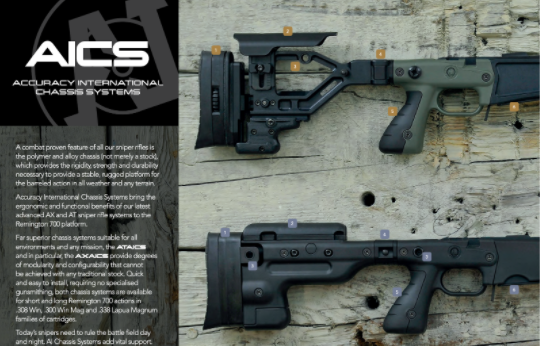
Image: A screen grab taken from a web-brochure displaying Accuracy International Chassis Systems.
Conclusion
What seems apparent from our research is that UK-made sniper rifles from Accuracy International are in the hands of Saudi forces, some of whom have operated in Yemen.
It has also been possible to find export licenses for sniper rifles the UK has granted after the start of the conflict there, including to the Saudi Navy. These licenses, however, do not name the manufacturer or the specific items that were approved for sale.
Saudi Arabia has been widely criticised for its role in the Yemen conflict and human rights groups have accused it of reckless and indiscriminate attacks on civilians.
Whether the UK should have granted licenses for the sale of sniper rifles after Saudi Arabia became involved in Yemen given its commitments and rules on arms control – which include taking caution in granting licenses for sale to countries where human rights abuses have been established – would also appear to be a pertinent question and call into doubt UK claims of a “strict” export licensing criteria.
It seems similarly relevant to ponder if and when Accuracy International sniper rifles were approved for sale to buyers in Saudi Arabia in order to discover how these weapons ended up on the field of battle in Yemen.
From Turkey to Syria
UK sniper rifle sales to Turkey have rapidly increased in recent years.
According to the UN Register for Conventional Arms (UNROCA), the UK exported just five sniper rifles to Turkey in 2009, and six in 2012. By 2016, however, that number had increased to 52, according to ATT data. In 2018, ATT figures showed that the UK had exported 102 sniper rifles to Turkey.
Separate data submitted by Turkey to the UNROCA, stated that Turkey acquired fifty .338 Accuracy Octagon sniper rifles from the UK in the same year:
The “.338” mentioned refers to the Lapua Magnum ammunition that most Accuracy International rifles employ (the AXMC, the AWM and other non AI-manufactured long-range sniper rifles ). And while “Octagon” does not appear to indicate a particular rifle model among AI’s range, it may be a direct translation of the Turkish denomination or reference to the forend component of the currently-marketed AI rifles models.
Image: A brochure details the AI forend mounting system. Source here
Further data collected by Campaign against the Arms Trade (CAAT) from UK Strategic Export Controls reports shows that the UK has granted 13 licenses for the sale of sniper rifles to Turkey since 2008. Of these, 11 were standard licenses (SIELs) and two were open licenses OIELs.
An OIEL granted in October 2016 permitted the unlimited sale of sniper rifles, amongst other things, to a number of countries, including Turkey. The end use was specified as: ‘for accessories / spare parts. Armed forces end use.’ A second OIEL was granted in December 2016 for the temporary sale of sniper rifles, amongst other things, to a separate list of countries, which included Turkey. The end use of this license was specified as: ‘for accessories / spare parts. Civilian / commercial end use.’
The end-user notes for the remaining 11 SIELS are as follows:
Through data provided in response to Freedom of Information requests by CAAT, we know that AI applied for a license to sell ML1a items (small arms – weapons) to Turkey twice between September 2007 and December 2015. Given the FOI request was submitted in 2016, it is possible that AI applied for more licenses to sell ML1a items after these dates.
Yet due to paucity of the data in the SIEL and OITCL end notes, it is not possible to say which, if any, of the approved licenses were awarded to Accuracy International.
Again, we sought to see if we could find the weapons being used by Turkish troops in live operations.
We were aware, however, that some lookalike sniper rifles are also made in Turkey. Turkish company, Kale Defence, manufactures a copy of the Accuracy International AX50 rifle model. It is showcased here in the 2019 Turkish Defence Industry product Catalogue and recently entered the inventory of the TSK.
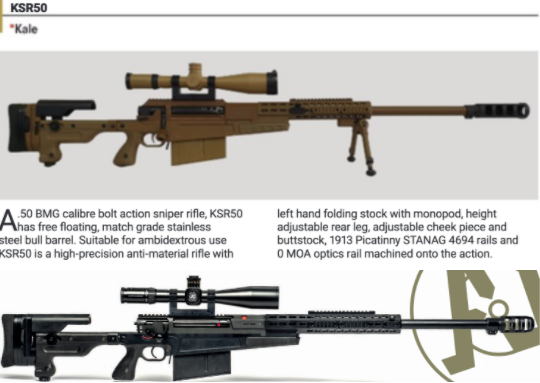
Image: A comparisson between the Kale KSR50 (top) and the Accuracy International AX50 (bottom)
Yet despite these similarities, we were able find some Turkish soldiers were equipped with AI rifles. An example can be seen here and compared to the screen grab below taken from the Forgotten Weapons YouTube channel.
More images of Turkish forces bearing AI rifles were filed in a report for Turkish state news agency, Anadolu. In one image, it is possible to have a closer look at the rifle’s scope, which bears a capital “AI” in white. This is consistent with the scopes that equip AI rifles.
According to the caption accompanying the Anadolu images, the picture of the sniper was taken on February 15, 2018, in Afrin, Syria. The sniper was reportedly a member of the Turkish Special Forces that supported ‘Operation Olive Branch’ – a controversial Turkish military campaign in the north of Syria.
A video published by Anadolu shows the sniper at the same location. In the film, his rifle can be seen up close. Of particular interest is the upper receiver’s left side, where the manufacturing company and country of origin of the rifle is carved. This is a feature of this model of AI rifles. “Accuracy International England,” it appears to read.
Image: A screen Grab from Anadolu news report
The same markings appear visible in the Forgotten Weapons YouTube video that reviews the gun.
Image: Screen grabs from the Forgotten Weapons Youtube channel (top and bottom)
In order to further confirm that UK-made sniper rifles were being used by Turkish forces in Syria, we can use the Anadolu video to geolocate the sniper’s position. One clip shows the sniper looking out over a valley below his position.
Given the photo caption helpfully stating it was taken in Afrin, Syria, this allows us to narrow down our search area. We can geolocate the sniper’s position to this location (36.636722, 37.031444) within Syrian territory.
Image top: A screen grab from an Anadolu news report. Bottom: A composite image from Google Earth showing the same location.
The Afrin mission of early 2018, detailed in the images above, was widely condemned. Human Rights Watch (HRW) criticised Turkey for having “failed to take necessary precautions to avoid civilian casualties” in several instances during the offensive.
Yet SIEL data appears to show that the UK granted export licenses for sniper rifles later that year.
Conclusion
Our investigation shows that the sale of UK-made sniper rifles to Turkey have been increasing in recent years, and have continued after the much criticised Afrin offensive.
Given the lack of clarity on export end use notes, however, it is not possible to conclusively state whether rifles sold after the Afrin offensive had begun were for military purposes. The SIEL end notes also do not name the manufacturer or the specific items which were approved for sale.
Yet questions remain on whether it was responsible to approve such licenses under the circumstances and the UK’s stated commitment to responsible arms sales
It seems similarly relevant to ponder if and when Accuracy International sniper rifles were approved for sale to buyers in Turkey in order to help discover how these weapons ended up in the hands of Turkish troops on the field of battle in Syria.
Again, the UK has commitments and rules on arms exports which include taking caution in granting licenses for sale to countries where human rights abuses have been established.
The Russia Connection
Exactly if and when Accuracy International began to sell its Sniper Rifles to Russian buyers is unclear. However, the AI rifle was being used by Russian forces as early as 2004. This is evidenced by photos taken by the photographer, Dmitri Beliakov, that show the weapons in the hands of a Russian sniper at the Beslan school siege.
Five years later, then-President of Russia Dmitri Medvedev was photographed using the rifle with the 7th Airborne Assault Division at the Rayevsky firing range in Novorossiysk. This army division had previously seen a large amount of combat in Chechnya. In 2010, Russian snipers – most likely members of the Federal Guard Service of the Russian Federation – were photographed with AI rifles on the walls of the Kremlin during a Victory Day parade rehearsal.
Data collected by Campaign against the Arms Trade (CAAT) from the UK Strategic Export Controls show that the UK had granted 18 Standard Issue Export Licenses permitting the sale of 191 sniper rifles to Russia since 2008 (although some of these sales appear to later have been impacted by the 2014 EU arms embargo on Russia).
According to the UN Register for Conventional Arms, the UK exported 32 sniper rifles in 2011, 15 in 2009 and 10 in 2008. Furthermore, according to the UK Strategic Export Control report of 2013, the UK exported 106 sniper rifles to the Russian Federation in 2012.
Yet the EU arms embargo imposed on 31 July, 2014, in response to Russian aggression against Ukraine meant that, as of September 2014, the sections of six Standard Issue Export Licenses that permitted the sale of sniper rifles were revoked. This meant that the total number of sniper rifles permitted for sale from the UK to Russia and recorded in between 2008 and 2014 was halted at 109. The footnotes on the licenses granted for 44 of these sniper rifles list them as for “sporting and hunting end use,” while 14 are listed as for “personal use”. There is no information available about the end-user for the remaining 51 and, interestingly, no mention of any end military use.
Thanks to a Freedom of Information request by CAAT, we know that AI applied for a license to sell ML1a (small arms- weapons) and PL5017 (equipment and test models) items to Russia in 2014. Given that no licenses have been approved for the sale of sniper rifles to Russia since 2013, it is reasonable to assume that this application was refused.
Despite all this, AI rifles appear to still be being used in Russian military operations given we were able to find the rifles being used in conflicts and incidents after 2014. Again, these weapons were likely purchased before the 2014 embargo was introduced.
First we spotted an Accuracy International rifle being used by Russian troops in the Republic of Dagestan in 2015 during the remnants of an insurgency there, a campaign that HRW said was accompanied by repression.
The rifle was being used during a battle with insurgents near the village of Gimry in Dagestan as is evident in a video of the assault. Two alleged militants (locals) and a Russian soldier were reportedly killed in the shootout on the 23rd of June.The approximate location of the sniper nest used during the operation can be geolocated to a hillside overlooking the road and valley. In one still from the video, the telephone poles and barriers on the side of the road can be matched to satellite imagery. In another wide shot of the valley, the location of an urban area and curvature of rock formations offer further corroboration that the video was indeed shot here (42.748962, 46.844824) outside Gimry
Image top: A still from a video of a firefight filmed near Gimry in Dagestan, Russia, that shows a sniper with an Accuracy International rifle shortly after a bullet was fired. Bottom: A Maxar satellite image showing the same location.
Image top: A still from the video that shows the sniper unit and a wide shot of the Gimry valley. Bottom: Google Earth images showing the same location.
We also found video reports from Russian media that the FSB (Russian security services) employed an Accuracy International AX-pattern rifle during a 2017 anti-terrorism exersice in annexed-Crimea as visible in the foreground below. The exercise occurred from May 24 to May 29, 2017. Crimea was annexed by Russia in 2014, but is still internationally recognised as part of Ukraine.
Image: An AX-pattern rifle being used during the FSB counter-terrorism exercise in Crimea. Clear distinguishing features on the rifle include the placement of the rivets, receiver shape, stock, hand guard in addition to the shape, size and placement of lightning cuts. The still was taken from a post on the VK social network that shows the exercise. Another version of the video can be viewed on Facebook.
This was not the last time Russian forces were spotted with an Accuracy International rifle in Russian-occupied Ukraine. In May this year, the Ukrainian army released footage of a sniper unit on the side of the separatists and Russian occupation forces in the Donbass region of eastern Ukraine with what they claimed was an Accuracy International rifle. They presented this footage along with satellite imagery showing that the footage could be geolocated to the frontline village of Donetskyi in the Russian-controlled part of the Luhansk Oblast of Ukraine. According to the Ukrainian army, the platoon was an FSB unit that was responsible for the death of one Ukrainian soldier – namely 47-year-old Vladimir Fedchenko who was reportedly killed by a sniper’s bullet on 27 February 2020 near Novotoshkivske (a village opposite of Donetskyi on the Ukrainian side of the frontline).
We were able to confirm that the footage was indeed recorded on the outskirts of the village of Donetskyi as the platoon can be seen walking through the garden of this house). Having obtained five HD videos of this footage, we were also able to confirm that the rifle in this video indeed concerns an Accuracy International model, more specifically one that belongs to the AX-series:
Image: The handguard, presence of certain groves and locking mechanisms on the buttstock in combination with the keyhole pattern near the barrel shows that this is an Accuracy International AX-pattern rifle. Still taken from this video.
Using facial recognition search, we were also able to identify one of the platoon members in this video as a man who had been posting photos of himself serving in the Prizrak Brigade – an infantry unit of the separatists of the so-called Luhansk People’s Republic – on his VK profile since 2015. On this profile he has the name Vitaly Petrov and is described as living in Moscow. Many of the people in his friends list either reside in Russia or in separatist-held territory in eastern Ukraine. We have been unable to identify the other members in the platoon, and have therefore been unable to check whether they served with the FSB or the Russian Armed Forces.
Image: In this frame the rifle is also in good view. On the right is Vitaly Petrov. Still taken from this video.
Vitaly Petrov (front right) in a group photo with other separatist militants from his VK profile found via facial recognition website Findclone.ru.
Since we found no information that the Accuracy International rifle was ever sold to Ukraine, the most obvious explanation is that this rifle came from Russia.
The transfer of sniper rifles by Russia would also be in line with a plethora of evidence relating to the transfer of weapons and manpower across the border into Ukraine that Bellingcat has gathered over the years.
Conclusion
While our research documents British made AI rifles being used by Russian snipers over a number of years, we found no indication of arms embargo breaches or that licenses had been granted after Russia’s intervention in Ukraine.
Nevertheless, the fact that the UK allowed the sale of these weapons to Russia before 2014 can also be seen as controversial given Russia had been accused of human rights violations going back to the Chechen War and the insurgency in the North Caucasus that followed. This also includes accusations by human rights groups that Russian marksmen had shot and killed multiple civilians using sniper rifles during the Second Chechen War.
Again, the UK is obliged to ensure caution is taken in granting licenses for sale to countries where human rights abuses have been established.
Our research also discovered incidents of Accuracy International sniper rifles being used in Russia and by Russian/pro-Russian forces in neighbouring Ukraine after the 2014 embargo. The quality and durability of the rifles, however, likely means they were acquired prior to the EU arms embargo in 2014.
Response
Both the UK government and Accuracy International were contacted as part of the UK Arms project.
Accuracy International did not respond before publication.
A spokesperson for the UK government said: “The UK operates one of the most comprehensive export control regimes in the world.
“The Government takes its export responsibilities seriously and rigorously assesses all export licences in accordance with strict licensing criteria. We will not issue any export licences where to do so would be inconsistent with these criteria.
“The Government also supports responsible defence and security industries, which make an important contribution to the UK’s global economic competitiveness, as well as sustaining tens of thousands highly skilled manufacturing and engineering-based jobs across the UK.”
